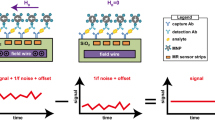Abstract
Nuclear magnetic resonance (NMR) is one of the prime modalities for probing molecular structure in the biomedical context and analyzing bulk material properties for quality control, food product analysis, and nondestructive testing. Conventional state-of-the-art NMR spectroscopy systems utilize bulky superconducting magnets, have a room-filling size, and cost millions of euros. Over the past decade, advances in permanent magnet technology have led to the availability of benchtop NMR spectrometers and even smaller NMR relaxometers for analyzing bulk material properties and performing immunoassays. With the availability of these smaller NMR magnets, NMR electronics have entered the focus of attention as a key component for miniaturized, portable NMR devices. Here, the on-chip NMR approach, in which all required electronics are realized on a single integrated circuit, allows for a realization in an ultra-small form factor and offers great promise for reducing the overall system cost. In this chapter, a comprehensive and self-contained overview of the on-chip NMR approach in the biomedical context will be given. After an introduction into the topic, the physical origin of the NMR signal will be discussed together with means of exciting and detecting it. This is followed by a review of conventional NMR electronics, including its key performance metrics. In the main part of this chapter, the NMR-on-a-chip approach is introduced, and its advantages and disadvantages are highlighted. Finally, the chapter is concluded with a summary and an outlook on the possibility of enhancing the achievable performance of the NMR-on-a-chip approach with on-chip dynamic nuclear polarization (DNP) capabilities.
Similar content being viewed by others
References
Badilita V, Meier RC, Spengler N, Wallrabe U, Utz M, Korvink JG (2012) Microscale nuclear magnetic resonance: a tool for soft matter research. Soft Matter 8(41):10,583–10,597
Blümich B (2019) Essential NMR: For Scientists and Engineers, Second Edition. Springer
Blümich B, Singh K (2018) Desktop NMR and its applications from materials science to organic chemistry. Angew Chem Int Ed 57(24):6996–7010
Bürkle H, Schmid K, Klotz T, Krapf R, Anders J (2020) A high voltage CMOS transceiver for low-field NMR with a maximum output current of 1.4 app. In: 2020 IEEE International Symposium on Circuits and Systems (ISCAS), IEEE
Danieli E, Perlo J, Blümich B, Casanova F (2013) Highly stable and finely tuned magnetic fields generated by permanent magnet assemblies. Phys Rev Lett 110(18):180,801
Davoodi H, Jouda M, Korvink JG, MacKinnon N, Badilita V (2019) Broadband and multi-resonant sensors for NMR. Prog Nucl Magn Reson Spectrosc 112–113:34–54. https://doi.org/10.1016/j.pnmrs.2019.05.001. http://www.sciencedirect.com/science/article/pii/S0079656519300056
Emwas AH, Luchinat C, Turano P, Tenori L, Roy R, Salek RM, Ryan D, Merzaban JS, Kaddurah-Daouk R, Zeri AC et al (2015) Standardizing the experimental conditions for using urine in NMR-based metabolomic studies with a particular focus on diagnostic studies: a review. Metabolomics 11(4):872–894
Enz CC, Vittoz EA (2006) Charge-based MOS transistor modeling: the EKV model for low-power and RF IC design. Wiley, Hoboken
Gonzalez G (1996) Microwave transistor amplifiers analysis and design. Prentice-Hall, Inc, Upper Saddle River
Grisi M, Vincent F, Volpe B, Guidetti R, Harris N, Beck A, Boero G (2017) NMR spectroscopy of single sub-nl ova with inductive ultra-compact single-chip probes. Sci Rep 7:44,670
Grisi M, Conley GM, Rodriguez KJ, Riva E, Egli L, Moritz W, Lichtenberg J, Brugger J, Boero G (2020) NMR microsystem for label-free characterization of 3d nanoliter microtissues. bioRxiv. Nature Scientific Reports, Volume 10 https://www.nature.com/articles/s41598-020-75480-0
Ha D, Paulsen J, Sun N, Song YQ, Ham D (2014) Scalable NMR spectroscopy with semiconductor chips. Proc Natl Acad Sci 111(33):11,955–11,960
Handwerker J, Anders J (2016) IC-based and IC-assisted μNMR detectors. Micro Nano Scale NMR 11(1):143–176
Handwerker J, Eder M, Tibiletti M, Rasche V, Scheffler K, Becker J, Ortmanns M, Anders J (2016) An array of fully-integrated quadrature tx/rx NMR field probes for MRI trajectory mapping. In: ESSCIRC Conference 2016: 42nd European Solid-State Circuits Conference, IEEE, pp 217–220
Handwerker J, Perez-Rodas M, Beyerlein M, Vincent F, Beck A, Freytag N, Yu X, Pohmann R, Anders J, Scheffler K (2020) A CMOS NMR needle for probing brain physiology with high spatial and temporal resolution. Nat Methods 17(1):64–67
Hoult D (2011) The principle of reciprocity. J Magn Reson 213(2):344–346
Josephson L, Perez JM, Weissleder R (2001) Magnetic nanosensors for the detection of oligonucleotide sequences. Angew Chem 113(17):3304–3306
Keeler J (2011) Understanding NMR spectroscopy. Wiley, Chichester
Lei KM, Heidari H, Mak PI, Law MK, Maloberti F, Martins RP (2016) A handheld high-sensitivity micro-NMR CMOS platform with b-field stabilization for multi-type biological/chemical assays. IEEE J Solid-State Circuits 52(1):284–297
Levitt MH (2013) Spin dynamics: basics of nuclear magnetic resonance. Wiley, Hoboken
Matzkanin GA (1989) A review of nondestructive characterization of composites using NMR. In: Nondestructive characterization of materials. Springer, pp 655–669
Perez JM, Josephson L, O’Loughlin T, Högemann D, Weissleder R (2002) Magnetic relaxation switches capable of sensing molecular interactions. Nat Biotechnol 20(8):816–820
Solmaz NS, Grisi M, Matheoud AV, Gualco G, Boero G (2020) Single chip dynamic nuclear polarization microsystem. arXiv preprint arXiv:200303291
Sporrer B, Wu L, Bettini L, Vogt C, Reber J, Marjanovic J, Burger T, Brunner DO, Pruessmann KP, Tröster G et al (2017) A fully integrated dual-channel on-coil CMOS receiver for array coils in 1.5–10.5 t MRI. IEEE Trans Biomed Circuits Syst 11(6):1245–1255
Sun N, Ham D (2013) Handheld NMR systems and their applications for biomolecular sensing. In: Point-of-Care diagnostics on a chip. Springer, pp 177–196
Author information
Authors and Affiliations
Corresponding author
Editor information
Editors and Affiliations
Rights and permissions
Copyright information
© 2021 Springer Science+Business Media, LLC, part of Springer Nature
About this entry
Cite this entry
Anders, J., Dreyer, F., Krüger, D. (2021). On-Chip Nuclear Magnetic Resonance. In: Sawan, M. (eds) Handbook of Biochips. Springer, New York, NY. https://doi.org/10.1007/978-1-4614-6623-9_23-1
Download citation
DOI: https://doi.org/10.1007/978-1-4614-6623-9_23-1
Received:
Accepted:
Published:
Publisher Name: Springer, New York, NY
Print ISBN: 978-1-4614-6623-9
Online ISBN: 978-1-4614-6623-9
eBook Packages: Springer Reference EngineeringReference Module Computer Science and Engineering




